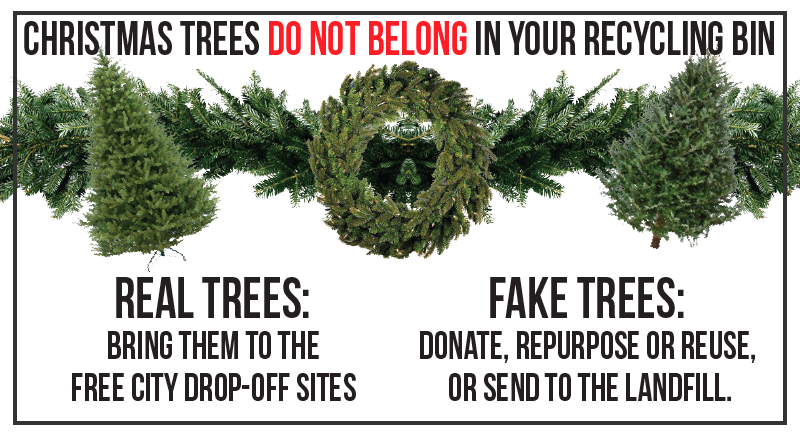Part 3 – Environmental Impacts of Disposal
The Life Cycle Analysis reports of real vs. plastic Christmas trees that I described in last week’s post generally concluded that when it comes to the environmental impact of our Christmas tree choices, it mattered less which tree you chose and more what you did with it once you had it. Consumer behavior for both options can make a huge difference and represented the biggest unknown variables considered in the studies.[1]
The Power of Our Decisions
For the plastic tree, the question was how long will the consumer reuse the tree, rather than purchasing a new one every year. The 2018 LCA indicated that the break-even point was about five years – that reusing a plastic tree for five years has the equivalent environmental impact as buying real trees five years in a row, and that if you could reuse a plastic tree for longer than that, plastic would be preferable from an environmental standpoint.
If you wanted to further increase the eco-friendliness of your decisions, you could purchase an artificial tree second-hand, as Christian did before I moved in, and/or give it away to be used by someone else, as Christian did after I moved in. However, the report only looked at the environmental impacts related to resource use and global warming potential, not human health hazards. We’ve also seen that keeping PVC trees longer than about nine years increases the risk of exposure to volatile organic compounds as the plastic degrades.[2]

For real trees, the question was what method of disposal the consumer chose, and the LCA examined three different scenarios: landfilling, incinerating, and composting. In the study, their analysis assumed that the landfill captured methane, which was used to generate electricity for the US power grid; that the municipal facility in charge of incineration produced steam-generated electricity for he US power grid; and that the composting facility emitted 6kg of carbon dioxide, 20g of methane, and 1g nitrous oxide per tree.[4]
Their assumptions put landfilling above composting as the environmentally responsible choice, which raised a huge red flag for me. For years I have composted anything I can at home, rather than sending it to a landfill, including my cat litter.[5] One of my most-used soap box topics is that opting for compostable single-use products does nothing for the environment if you send them to the landfill (and only costs you more money as you buy more expensive products). So my next step was to compile information to see how realistic their assumptions were and what my future actions should be when it comes to Christmas tree disposal.
Landfilling vs. Composting
Organic matter breaks down in landfills through anaerobic decomposition, meaning oxygen is not part of the process. Municipal solid waste landfills are (or are required to be) lined and sealed so that harmful chemicals do not seep into the surrounding land.[6] The result is a lack of oxygen, which changes how biological matter decomposes. The gas emissions from the landfilling process are called landfill gas (LFG), which is about half carbon dioxide and about half methane.
Composting, on the other hand, incorporates oxygen as part of the process and releases mostly carbon dioxide. Of course, an untended backyard compost pile can undergo anaerobic decomposition and create methane as well if it isn’t tended properly with frequent turning and a healthy mix of green and brown material.[7] The point, however, is that even the EPA recommends composting biological material before landfilling it because the resulting methane is such a potent greenhouse gas. NB: they do rank “digestion to recover energy” above composting, but therein lies another problem.[8]

The Christmas tree LCA showed very low impacts from the landfilled tree because they assumed the methane produced in the landfill would be captured to generate electricity. This assumption is quite the optimistic one because of the approximately 2,600 US landfills currently tracked by the EPA, only about 500 capture methane for energy production.[10] Furthermore, even the best methane capture technology is only estimated to be between 60% and 90% effective.[11]
Regarding incineration, there are 75 facilities in the US that incinerate municipal solid waste to generate steam for electricity. After the waste is incinerated, the ash is collected and landfilled.[12] A 2009 study compared the efficiency of capturing landfill gas and incinerating waste for electricity production. The result indicated a significantly higher level of CO2-equivalent emissions from landfill gas capture than from waste incineration.[13] Based on this information, it does seem that landfilling, which appeared to be the best option in the LCA’s recommendations, is the worst in practice, at least from a greenhouse gas standpoint.
Christmas Tree Disposal
As for my own options at home, I do not have the ability to fit my Christmas tree into my relatively tiny backyard compost bin, and I know, thanks to some very depressing research this fall, that my municipality’s “composting” efforts only result in bagged yard waste landing in the same landfill as our garbage, just via a separate truck. So I have listed three alternatives below that loosely echo the three end-of-life scenarios described in the LCA, but I cannot yet speak to their environmental impacts beyond my best guess. All I can do is say that I have done each of them, for lack of better options in my area.

- Mulch it (probably not quite as good as composting, but close):
For those of you who live in Allegheny County, the Parks Conservancy collects Christmas trees and turns them into mulch for the county parks. Lights, decorations, and stands must be removed prior to dropping them off. Collection times run from 8am until dusk, starting on December 26, 2021 and running until January 14, 2022 at all nine county parks.[15] If you do not live in Allegheny County, check and see if a local park or conservation group near you runs a similar program. If you or a friend have a wood chipper, you can also make your own mulch. - Let animals enjoy it (probably better than landfilling, will decompose in the presence of oxygen):
I have heard that chickens, goats, and other animals enjoy picking at old Christmas trees. Some zoos even take tree donations for the animals to play with. The past few years we have taken our tree to up to our friends’ farm as a belated Christmas present for their goats. According to the Arbor Day blog, wild birds can nest in it if you have a place to leave it outside, as can fish if you have permission to sink it in a nearby lake or pond. Not being a chemist, I don’t know how much more the underwater option would contribute to methane emissions versus the above-ground options. - Burn it and spread the ash (definitely worse than incineration to create electricity, but with a garden benefit):
This option is not as widely-recommended as the others because by burning the tree, you’re releasing the carbon that it has gathered over its life (though one thing that articles eschewing this option don’t mention is that composting and landfilling also release carbon dioxide). Obviously municipal incineration for electricity production is preferable, if you can be sure that’s what’s going to happen to it when you put your tree in the garbage.
In any case, I have an outdoor fire pit, which I love. I am aware that wood smoke contains small particulate matter (PM2.5) and volatile organic compounds (VOCs), both of which I talk about ad nauseam on this blog and at work as being health hazards and exacerbating lung diseases. While I recognize that these hazards are absolutely real, I also experience utter joy sitting around a fire with friends, so I consider it a matter of weighing my physical and emotional health. Yes, I am rationalizing, but once the fire is done, you can atone by spreading the ashes in your garden beds to help nourish your plants with potassium, lime, and other nutrients.
Arbor Day’s blog also has some more creative options for the more artsy among you.[16] And speaking of creativity, be sure to check out next week’s post for the conclusion, where we will cover some less common alternatives in the battle of real vs. artificial Christmas trees.
~
If you get a real tree, how do you usually dispose of it when you’re done? Have you tried any of the methods mentioned above? I’d love to hear about it in the comments.
Thanks for reading!
[1] https://radicalmoderate.online/real-vs-plastic-christmas-trees-part-2/
[2] https://radicalmoderate.online/real-vs-plastic-christmas-trees-part-1/
[3] https://www.millenniumrecycling.com/christmas-trees-are-not-recyclable-real-or-fake/
[4] https://8nht63gnxqz2c2hp22a6qjv6-wpengine.netdna-ssl.com/wp-content/uploads/2018/11/ACTA_2018_LCA_Study.pdf
[5] https://radicalmoderate.online/kitty-litter-compost/
[6] https://www.epa.gov/landfills/municipal-solid-waste-landfills
[7] https://www.thespruce.com/composting-greens-and-browns-2539485
[8] https://www.epa.gov/sustainable-management-food/reducing-impact-wasted-food-feeding-soil-and-composting
[9] https://www.epa.gov/sites/default/files/2017-09/landfill_diagram.jpg
[10] https://www.npr.org/2021/07/13/1012218119/epa-struggles-to-track-methane-from-landfills-heres-why-it-matters-for-the-clima
[11] https://www.epa.gov/lmop/benefits-landfill-gas-energy-projects
[12] https://www.epa.gov/smm/energy-recovery-combustion-municipal-solid-waste-msw
[13] https://pubs.acs.org/doi/10.1021/es802395e
[14] https://www.bbc.com/news/uk-england-cambridgeshire-30655597
[15] https://www.alleghenycounty.us/parks/christmas-tree-recycling-program.aspx
[16] https://arbordayblog.org/holiday/8-sustainable-ways-to-recycle-your-christmas-tree/
0 Comments